Abstract
Understanding the dynamics of tree species and their demography is necessary for predicting future developments in savanna ecosystems. In this contribution, elephant-tree and firewood collector-tree interactions are compared using a multiagent model. To investigate these dynamics, we compared three different tree species in two plots. The first plot is located in the protected space of Kruger National Park (KNP), South Africa, and the second plot in the rural areas of the Bushbuckridge Municipality, South Africa. The agent-based modeling approach enabled the modeling of individual trees with characteristics such as species, age class, size, damage class, and life history. A similar level of detail was applied to agents that represent elephants and firewood collectors. Particular attention was paid to modeling purposeful behavior of humans in contrast to more instinct-driven actions of elephants. The authors were able to predict future developments by simulating the time period between 2010 and 2050 with more than 500,000 individual trees. Modeling individual trees for a time span of 40 years might yield more detailed information than a simple woody mass aggregation. The results indicate a significant trend toward more and thinner trees together with a notable reduction in mature trees, while the total aboveground biomass appears to stay more or less constant. Furthermore, the KNP scenarios show an increase in young Combretum apiculatum, which may correspond to bush encroachment.
1. Introduction
Trees are keystone species in savanna landscapes (as illustrated in Figure 1) and are highly adaptable to impacts from their surroundings [1,2,3,4,5]. Such impacts can include changes in soil conditions, temperature, and precipitation, as well as disturbances such as utilization and fire. Therefore, savanna tree species can withstand droughts and fire and have developed different strategies to avoid over-utilization by, e.g., browsing animals [6,7,8,9,10]. Savanna trees are also characterized by different life states, which sometimes have contradictory needs.
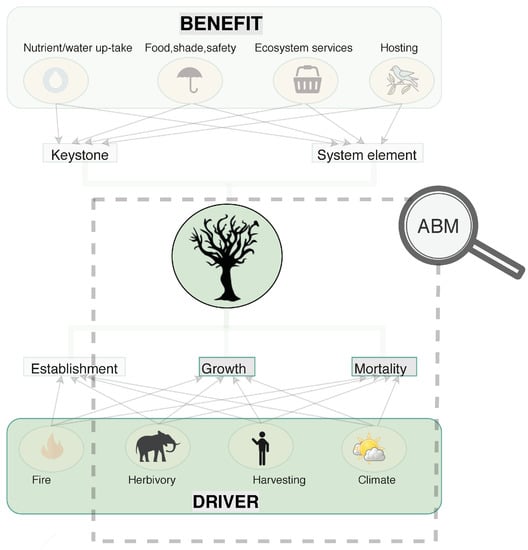
Figure 1.
Illustration of trees as keystone species in savannas, offering a set of benefits and being impacted by a set of drivers. The actors within the dashed square are modeled as agent types in the agent-based model.
To obtain a representative and comprehensive model, three tree species with different survival strategies [9] were included: Acacia nigrescens, Combretum apiculatum, and Sclerocarya birrea (Marula).
Acacia nigrescens (A.n.) is a tall, deciduous tree that stands without leaves for several months. Its height commonly ranges between 8 and 10 m, but can be up to 20 m. The juvenile and adult tree is resistant to fire and drought, and is favored by many browser species. This has a high impact on the survival rate from seedling to adult trees [11].
Combretum apiculatum (C.a.) is a small to medium-sized tree with a height between 3 and 10 m. This tree occurs in dry, open woodlands and the Bushveld. The hard wood is resistant to borers and termites [11].
Sclerocarya birrea (S.b.) is a 7–17 m medium-height, deciduous tree which is leafless for several months of the year. Nevertheless, these trees are an essential forage source for many animals. Its fruits, leaves, kernels, but also bark and roots, are attractive to several animals. The habitat ranges from medium- to low-altitude open woodland and bush [11].
Additionally, the model includes an average tree, called Tree tree (T.t.), to obtain an appropriate population density of trees throughout the spatial extent of the model (see Section 3.1.1).
Two study sites in the most extreme land-use forms of the savanna were chosen: a plot in the rural area of the Bushbuckridge Municipality (BBR) and a plot in the Kruger National Park (KNP) near Skukuza (SKU), as a near-natural example in a protected area. In Figure 2, the geographic locations of the study sites are shown. Both sites are part of the EMSAfrica (FKZ 01LL1801C) study site system and have a rich database [12,13,14,15,16,17,18,19,20]. After the selection of sites, the main agent types in addition to the four previously described tree species were identified: firewood collector and elephant (Loxodonta africana).

Figure 2.
Study site: Overview of Southern Africa showing (A) the location of the KNP, (B) the location of both study sites with respect to the KNP, and (C) the location of both study sites with respect to the adjacent KNP border and neighboring villages.
Many existing models aim to predict fuel wood demand [21,22,23,24,25,26] or to calculate the aboveground biomass (AGB) of trees in savannas [25,27,28,29,30,31,32]. However, a valid representation of adaptable human behavior has been absent in models of nonlinear systems [33]. To begin to fill this gap, goal-oriented action planning (GOAP) [14] was employed. Here, wood collection was modeled on the household scale with preferences in the quality of firewood, which results from the tree species and the collected parts of wood.
Disturbances against trees by elephants are mainly driven by the location of the elephants and the time of day, rather than by the number of elephants [34]. In order to simulate elephant behavior realistically, the model is coupled with an existing KNP elephant model designed and developed by the MARS Group [35].
Additionally, fire is a disturber against trees in savanna landscapes. It can reduce woody cover [36] mainly by killing young trees and by setting back the height growth with a start of resprouting until the fire escape height is reached [37]. However, the frequency and intensity of fires is a function of fuel accumulation. Therefore, frequent burning is not always possible [36,38]. This is also the case in a plot of intensive firewood collection, such as the site near Bushbuckridge. The plot inside the KNP, on the other hand, has a low fire return frequency [39]. To avoid affecting the comparability of the study sites by special events such as fires, fire as a potential disturber is not included in the model. Generally, fire is an important aspect of the study of savanna ecosystems. However, fire is a relatively rare and low-impact source of disturbance in the two chosen study sites. While this does not make fire disturbances negligible, we argue that it allows for its exclusion in a model that aims to study the impact of utilization by animals and humans.
The impact of future climate is uncertain. In order to standardize these uncertainties, scenarios for model comparison purposes must be defined. New data sets were created and presented in the Intergovernmental Panel on Climate Change (IPCC) Fifth Assessment Report (AR5) with Representative Concentration Pathways (RCP) scenarios. The RCP name different scenarios with space- and time-dependent trajectories of human-made concentrations of greenhouse gases and pollution. In the model, two extreme RCP scenarios [40] are considered.
The research question of this contribution is whether a large-scale agent-based model (ABM) that is informed by spatio-temporal data from the pertinent geographic region is suitable for modeling and predicting future tree distributions. We argue that this approach complements previous efforts, which relied mainly on aggregations of AGB and/or up-scaling from an average value per ha. Using an ABM, we were able to model the life cycles of each single tree belonging to one of the three different tree species. This provides a greater level of detail and a potentially richer model output for further analysis. As such, the research objective is to develop a workflow that comprises a data-driven selection of agent types for the model, a literature-driven modeling behavior of each agent type, the specification of a range of scenarios to compare different tree distribution outcomes, the implementation of the designed model, and first analyses of model outputs. For more details, see the ODD Protocol (overview, design concepts, and details) [41,42] in Appendix A.
2. Study Area
To model distributions of specific savanna tree species, the research areas (see Figure 2) were placed in the Lowveld, one of the savanna biomes in South Africa with the vegetation type Granite Lowveld. Being in the Lowveld, both study sites are located within an altitude range of 150–600 m above sea level. The vegetation characteristics of this region typically consist of a few trees in tall shrubland up to dense thicket or open savanna [43].
The majority of annual rainfall occurs in the summer between October and May, with a mean annual precipitation of 570 mm in Skukuza and 640 mm in Bushbuckridge. The rainfall is driven mainly by thunderstorms with a high inter-annual variability, causing droughts to occur regularly. The temperature profile is characterized by hot summers and mild and dry winters [44]. Within this savanna biome, there are three main different land tenure systems: the state-owned communal areas (see Figure 2, BushbuckridgePlot), the state-owned conservation area KNP (see Figure 2, SkukuzaPlot), and a buffer zone that belongs to a system of privately owned conservation areas.
2.1. BushbuckridgePlot/BBR Model
One of the two main study sites of the EMSAfrica project [45] is located in the Bushbuckridge Municipality, south of Agincourt (−°, °). Throughout the paper, we refer to this site (represented by the orange square in Figure 2) as BushbuckridgePlot. The model that we implemented of this site is referred to as the BBR Model. The social structure is characterized by low-income households and the regular use of natural resources from communal lands [25,46,47]. 40% of the area is used for houses, streets, or agriculture land, while the remaining 60% is used for firewood collection. Additionally, there is little woody structure left on the first 1500 m south of Agincourt due to ongoing heavy firewood collection [48]. This was taken into account while calculating the space required for firewood collection.
2.2. SkukuzaPlot/SKU Model
The second study site of the EMSAfrica project is located 13 km southwest of Skukuza (°, °) [45]. We refer to this site (represented by the green square in Figure 2) as SkukuzaPlot and to its model as the SKU Model. Since 2000, there has been an eddy covariance flux tower to measure mainly CO2 fluxes [18]. Here, a nearly undisturbed savanna still exists. Additionally, data collection has been ongoing for nearly a century, allowing for reasonable estimates of the natural variances in this area [19]. The EMSAfrica Project declares a region of 16 km2 to be the collaborative research area. In this near-natural site, the primary disturbance agent of trees is the African Elephant (Loxodonta africana).
3. Method
Agent-based modeling is an assessed approach to modeling interactions between individuals and their impact on the modeled system [49]. Each agent is defined as an autonomous entity that can make decisions by using information from its environment and other agents. Rule-based behavior allows for the execution of various actions which represent the whole range of possibilities within the system [50]. Since the behavior choices of an agent depend on its internal state and its observations of the environment, the behaviors of agents tend to vary over time. A simulation of the model is divided into discrete time steps, and all updates in the environment and interactions of the agents are recorded. The used modeling framework, MARS (Multi-Agent Research and Simulation), is under development at the University of Applied Sciences in Hamburg, Germany. The group has worked on different topics but has focused mainly on designing large-scale ABMs [51,52,53]. The analyses and visualizations in this study were performed with the programming languages Python (version 3.7.x) and R (version 3.6.x) and the online GIS visualization tool https://kepler.gl (accessed on 19 April 2022). The setup of the ABM involved, firstly, a technical construction of the environment with different layers and, secondly, a realization of the different agent types with corresponding attributes and behaviors. All agents were designed as individual entities that sense the environment, their surroundings, as well as other agents with which they can interact. Additionally, the two climate scenarios were defined mainly to create minimum and maximum temperature, days of frost, and precipitation per day. The conceptual model of the ABM is shown in Figure 3. The workflow employed for this study covers data acquisition and integration, model development, scenario simulation, and result analysis and visualization (see Figure A1).
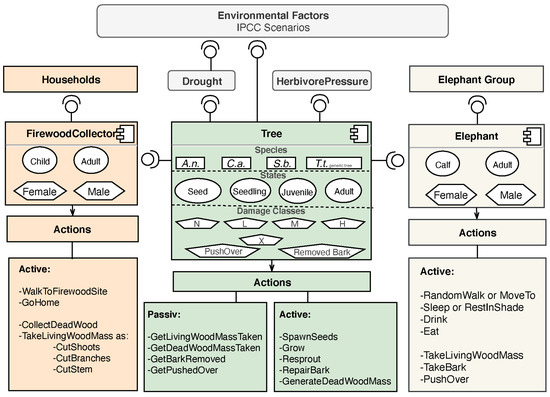
Figure 3.
Conceptual model of the implemented ABM. Each of the three agent types, FirewoodCollector, Tree, and Elephant, is defined by a set of attributes and equipped with a set of active and/or passive actions. A FirewoodCollector is associated with a Household, while an Elephant is associated with an Elephant Group. Trees are interfaced with EnvironmentalFactors and a HerbivorePressure component. These external forces, along with disturbances by FirewoodCollectors and Elephants, impact the state of Trees in the ABM. For more details, see Appendix B.
3.1. Agents
The research question focuses on the current and potential distribution of different tree species in Lowveld. The region is characterized by different land uses, making an inclusion of this feature in the question essential to the modeling process. This leads to the three agent types Tree, FirewoodCollector, and Elephant to compare human–tree to elephant–tree interactions. For more details on the structure and properties of the ABM, see Appendix A. For more details on the parameters and behavior routine of each agent type, see Appendix B.
3.1.1. Tree
The agent-type Tree is the key component of both models and, therefore, is identical in both models. Since trees in savannas have various strategies against disturbances, the agent-type Tree must represent a wide variety of behaviors. Much work has been conducted to describe these differences (see, e.g., [54,55,56,57,58]). Wigley et al. [56] collected data about leaf traits in different savanna trees. This data set was the fundamental resource for defining tree species in the ABM. For different survival strategy, the most abundant tree species Acacia nigrescens, Combretum apiculatum, and Sclerocarya birrea [9] were chosen. Additionally, to obtain a realistic density of trees in the simulation, a generic tree species named Tree tree was developed. It has attribute values mediated over the three selected tree species.
A key characteristic of the life cycle of savanna trees, illustrated in Figure 4, is the ability to return adult trees back to a juvenile state upon damage. If there is too much or too frequent damage, the tree remains a juvenile without any seed production. Damage can be caused by FirewoodCollectors or Elephants. The damage classes, modified after [59], are N (<10%), L (10–30%), M (30–60%), H (60–80%), and X (>80%).
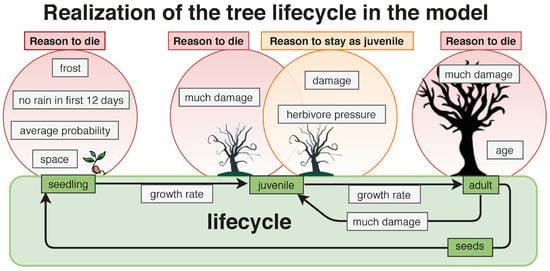
Figure 4.
Tree lifecycle: From seed to adult tree or back to juvenile.
3.1.2. Firewood Collector
A FirewoodCollector is an independent agent that is part of a Household in the BBR Model. A Household consists of six family members with daily firewood consumption. This consumption causes the FirewoodCollector to have to refill the firewood stock of the Household as needed. In pursuit of firewood, a FirewoodCollector can perform different actions, such as collecting dead wood or cuttings shoots [14]. Each action is weighted by a preference and a cost to reach the site of action, as listed in Table A3. Depending on the location of the agent, the surroundings are explored and the most preferable action is chosen until the capacity for a return is reached. The collection routine of a FirewoodCollector consists of moving to a reasonable position within the firewood site, orienting itself, and beginning collection. If no reasonable action is available (e.g., due to overcutting or distance), the FirewoodCollector might return without reaching its collection goal.
3.1.3. Elephant
The agent type Elephant is the main driver of tree damage in the SKU Model [47]. Female elephants are organized in family groups with one leading cow. The Elephant agents are executed in their own model [35]. A coupling between this model and the SKU Model allows Elephant agents to walk through the whole modeled KNP and interact with Tree agents in the SKU Model. (The MARS KNP base model and the elephant agent can be downloaded here: https://github.com/MARS-Group-HAW/KNP (accessed on 19 April 2022)). The elephant distribution of the KNP elephant model was based on helicopter counts performed in the KNP. Whether a single elephant or a herd of elephants is about to enter the SkukuzaPlot depends mainly on available water and a random factor. For more details, see [35]. As Figure A5 shows, damage to the trees varies depending on the month, tree species, droughts, and the state of the tree [59,60,61,62].
3.2. Layers
Along with agents, the environment is a key component of an ABM. In an ABM designed with MARS, the environment is made up of multiple layers. Each agent has a georeferenced coordinate that describes its location in the environment. The environment, in turn, comprises several time-series layers that hold, for example, climate data. By querying these time-series layers, an agent can sense environmental attributes such as, for example, temperature, precipitation, and aggregated data such as the sum of precipitation within the last 12 days. In this model, the environment is made up of an ElephantLayer, a FirewoodCollectorLayer, and a TreeLayer, each as an organization unit. Furthermore, the model includes a TemperatureLayer, a PrecipitationLayer, and a DroughtLayer. The TemperatureLayer comprises time-series data that provide daily maximum, minimum, and average temperature to querying agents. The PrecipitationLayer includes daily precipitation and a function to calculate precipitation for a given interval. The DroughtLayer results from the precipitation layer and serves to switch between average-year and drought-year attribute values in Tree agents. In a drought year, all seeds and seedlings die, and juveniles die at a random probability between 7% and 15% [63]. When a Tree is alive, the deadwood production is 1.7% of the AGB [64]. Even when there is no firewood collection or damage by elephants, the AGB is regularly reduced by herbivores, pastorals, and insects [19,65]. Therefore, a HerbivorePressureLayer was included to manage the reduction in biomass for each Tree once a year.
3.3. Parameterization
Due to the favorable quantity and quality of data in both research areas, no infield data collection was performed specifically for this study. Instead, existing data were used for the parametrization and initialization of the model. Each Tree agent must have its own lifecycle covering the stages seed, seedling, juvenile, adult, and dead, with corresponding parameters (see Table 1). In Appendix B.1, a more detailed description of each attribute of the Tree agent type is provided: state (age class), living and dead wood mass, maximum stem diameter, number of days with photosynthetic activity per year, damage type, juvenile growth rate, adult growth rate, first time of seed production, number of seeds, space needed for germination, mortality after drought for seeds, juveniles and adults, time span from seedling to juvenile, and days of precipitation as a seed [2,17,59,64,66,67,68].

Table 1.
Tree parameters per modeled species.
For the parametrization of firewood collectors [15,25,69], we tried to map the conditions of Agincourt (see Table 2). The collecting area is located south of the village. The km study sites of the EMSAfrica project correspond to the collection area for half of the inhabitants. In total, only 40% of the area is suitable for firewood collection [48] and the first 500–1500 m are strongly overharvested [25]. Therefore, 100 ha in the center of the study site were modeled. For the BBR Model, it was calculated that 56 FirewoodCollector agents represent 336 inhabitants of Agincourt for these 100 ha. This corresponds to 4104 people in 684 households, which equals half of the population of Agincourt in 2017 [48]. For more information, see Appendix B.2.

Table 2.
Firewood collector parameters.
Since the elephant model is a coupled model, other requirements apply here. The elephants can move freely throughout the KNP model and live their daily lives there [35]. They enter the elephant–tree interaction submodel only when they come close to the geographic extent modeled by the SKU Model. Thus, the parameterization for this model is limited to what the elephants do when they are in the SKU Model (see Section 3.1.3). Due to the high complexity of the model coupling, the study area is limited to 9 ha. For more information, see Appendix B.3.
3.4. Initialization
Tree distribution of the given AGB is related to the measured distribution of tree species and their age classes for both sites [17,18,25,33,47,70,71]. Tree agents were generated only once for the BBR Model and once for the SKU Model by applying the data from Table 3 and Table 4, respectively. Their georeferenced placement in the environment was performed at random. The initialization process produced a comma-separated values (CSV) file with all generated trees including their georeferenced position, species, stem diameter, and age state. The total AGB differs from 10 t/ha [33] in the rural area to 23 t/ha [17] in the KNP.

Table 3.
Tree initialization in the BBR Model.

Table 4.
Tree initialization in the SKU Model.
3.5. Scenarios
This study includes models of two sites, the BushbuckridgePlot and the SkukuzaPlot (see Section 2.1 and Section 2.2, respectively), with different tree disturbance agents. In South Africa, the temperature has increased over the last few decades. Additional climate change is projected to lead to temperature increases of up to 6 °C and changing precipitation patterns [72]. In order to have a first meaningful comparison, the two extreme climate scenarios RCP 4.5 and RCP 8.5 were selected (see Table 5).

Table 5.
IPCC Scenarios (RCP and RCP ).
RCP (intermediate emission) represents a scenario with stabilization without overshoot pathways to W/m2. This is roughly equal to 650 ppm CO2 equivalents and stabilization after 2100 [73].
RCP (high emission) represents the most extreme scenario, with three times the current CO2 emission in 2100. The radiative forcing pathway leads to W/m2, which is roughly equal to 1370 ppm CO2 equivalents by 2100 [73].
Additionally, a growth boost and a higher seedling survival rate was modeled for the RCP 8.5 Scenario [74] to emphasize the higher level of CO2 (see Table 5). In order to make the experiments comparable, input data from the adaptive Dynamic Global Vegetation Model (aDGVM) were gathered [24,40]. The threshold value for a drought was set to 65% of the average precipitation in a vegetation year.
Preconfigured MARS models for both scenarios executable on Windows, macOS, Linux systems can be downloaded here: https://git.haw-hamburg.de/mars/model-deployments (accessed on 19 April 2022).
4. Results
The raw simulation output includes data for each tick of each agent. To make the different scenarios more comparable, these raw results were accumulated per 1 ha. The variable year represents the vegetation year, which starts on October 1 of the current year. Even if drought conditions apply in the respective drought year, their effects can be observed only in the following year.
Altogether, data from four scenarios were compared. For two climate scenarios, this results in more than 500,000 individual trees, each of which goes through its daily routine over the course of 40 years. Since one tick represents a 24 h day, this is equal to 14,600 simulation steps per Tree agent.
All results show that there are only marginal differences between the two climate scenarios. This is caused by the fact that their trajectories differ only slightly during the first several years of the simulation time frame. Additionally, the response to changes in climate by trees takes decades because of their long life cycle.
4.1. Trees
In this study, differences between two extremely different forms of land use were highlighted (see Figure 5a).
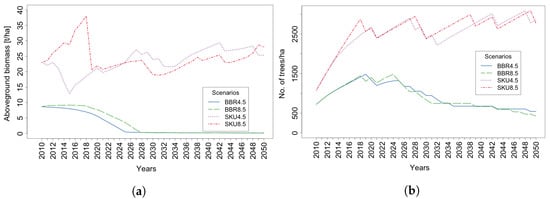
Figure 5.
(a) Total AGB of all trees in t/ha summed across all species, and (b) average number of trees in one hectare summed across all species.
The two scenarios of the BBR Model each start with a biomass of about 10 t/ha, which stays relatively stable in the first years of RCP . Biomass increases moderately in the RCP Scenario. Continuous firewood extraction decreases the total amount of AGB remarkably. However, thereafter, the amount remains at a lower level.
The trajectories of the two scenarios of the SKU Model differ from one another for the first few years but converge eventually. This effect is caused by the elephants that visited the site earlier in the RCP run. After that point, both time series show a similar development, with a slight upward trend.
In Figure 5b, all four scenarios show an increase in the total number of trees in the first seven years. Due to a stable AGB, this must be a trend toward more but thinner trees. For the BBR Model, the analyses show that even in times when there is nearly no AGB, a considerable number of trees exists in the scenario. This means that the diameter must be minimal.
The differences in the RCP scenarios are driven mainly by the different droughts that cause the death of many trees. However, within the near-nature SKU Model, the numbers always recovered after a few years.
In Figure 6a–d, the results are stratified by age class. The amount of AGB, as well as the number of trees, is mainly driven by the age class Juvenile. Here, we were not able to distinguish between juveniles that become adults and juveniles that remain in their current state (see Figure 4).
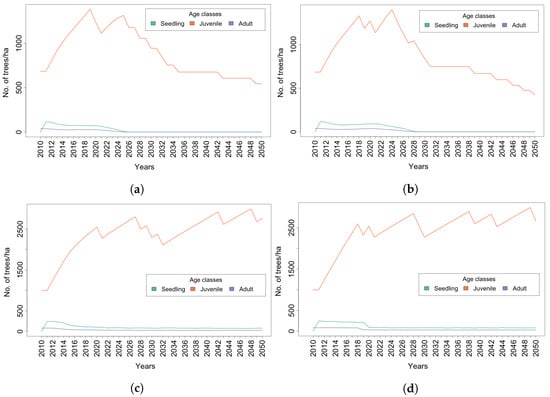
Figure 6.
Results grouped by age class per hectare and summed over all species for (a) BBR RCP Scenario, (b) BBR RCP Scenario, (c) SKU RCP Scenario, and (d) SKU RCP Scenario.
However, the results (see Figure 7) indicate that all adult trees in the rural area will be lost under ongoing firewood collection. In the KNP, a high loss of big trees over the last years was observed. Nevertheless, it seems that the number of adult trees is stabilizing.
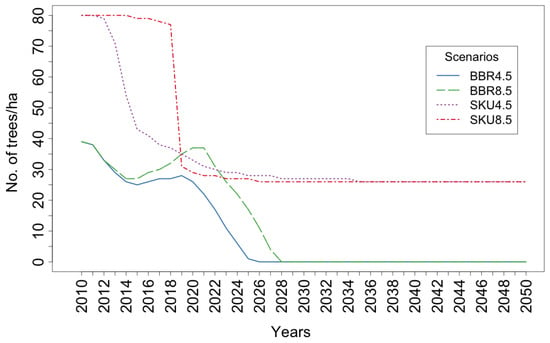
Figure 7.
Number of adult trees in one hectare (sum of all species).
4.2. Tree Species
For the three tree species considered (see Figure 8a–d), the results are heterogeneous. In the BBR Model, irrespective of the scenario, there are only two A.n. individuals per ha. Even with the total number of trees, which is more than 450,000 at this site, it is difficult to detect a clear trend. In total, a rare species becomes even rarer over time.
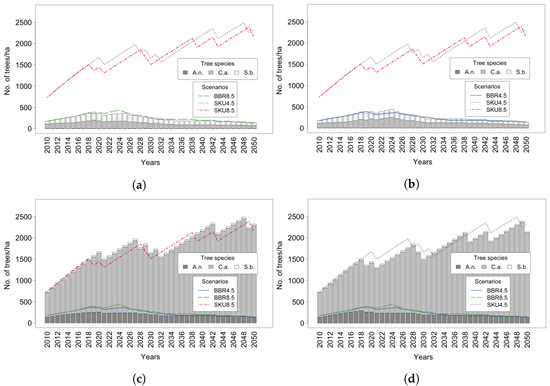
Figure 8.
Distributions of Tree species A.n., C.a., and S.b. in (a) BBR RCP Scenario, (b) BBR RCP Scenario, (c) SKU RCP Scenario, and (d) SKU RCP Scenario.
For the SKU Model, the number of single trees is similar from 2010 to 2050, with higher numbers in between. Here, A.n. seems to be more stable than outside the protected areas.
C.a. shows the most significant differences across sites. In the rural area, the number of trees is declining; in the SKU Model, however, a fourfold increase in trees within the 40 simulated years were observed. Surprisingly, the RCP Scenario produces higher numbers than the RCP Scenario.
S.b. plays a unique role in rural areas. Since it is forbidden by law to cut down an adult tree, a stable number of Marula trees can be observed over a long time. This tree species was harvested only when other sources of firewood became scarce. There is still a stable number of trees in both climate scenarios. However, these are mainly juvenile trees, as mentioned before (see Figure 4).
However, because of the declining number of adult trees (see Figure 7), each tree with the damage class Extreme or Dead changes the age class distribution to more juvenile trees and fewer adult trees.
5. Discussion
This study aimed to compare the current and future distribution of savanna trees at the individual level for two different forms of land use and under two different climate scenarios by comparing the results of differently parameterized simulations of a large-scale ABM.
The findings suggest extreme differences between the two types of land use. In the rural area, there will be a substantial loss of trees under ongoing firewood collection and land use change [16,25,47,75]. Even if the projections are hyperbolized, the decreasing number of adult trees will destabilize the system. However, the results also show that there are still enough individual trees to potentially stabilize the site. For this to happen, the ongoing firewood collection must be regulated.
In the SKU Model, the AGB seems to fluctuate only slightly but with a significant trend toward more and thinner trees [76]. This is mainly driven by an increasing number of juvenile C.a. trees. This finding corresponds to a potential shift in the species composition and bush encroachment [16].
To compare the forms of land use, the main disturbers of trees were modeled. The agent type FirewoodCollector was modeled with GOAP to show adaptive behavior in starting to collect less firewood as a result of changing conditions at the site after some time of overharvesting. Nevertheless, the total number of extreme damage to trees, inflicted by coppicing or tree felling, is extremely high [47,70].
Elephant damage is most detrimental in the damage class Low, which means damage up to 30% [34]. Such damage seems to regulate the biomass in total. However, all pushover and ringbarking of adult trees changes the tree distribution because of a lack of upcoming new adult trees [22,61].
This research suggests no significant differences between the two considered climate scenarios. Here, the strongest differences in temperature and precipitation do not start until 2050. Hence, the time frame of the simulations would need to be extended in order to detect potential long-term differences in tree distribution due to differences in climate projections.
In all four scenarios, a loss of adult trees was observed. Even if savanna trees have a high potential of recovering after damage, fewer adult trees imply fewer seeds over time. Therefore, every single tree that disappears from the landscape might have a destabilizing effect on the tree–grass savanna system. Seeing elephants as agents that rebuild the savanna over time [34] can help to understand the future distribution of mature trees.
The situation looks more dramatic in the rural areas, where the demand for firewood will no longer be covered sustainably by the ecosystem. When the preferred stem diameter, i.e., 4–10 cm, becomes scarce, the FirewoodCollector resorted to cutting down larger trees [25]. Both disturbers covered by this study can create specific spatial patterns without adult trees [47]. A few healthy mature trees can stabilize the savanna system. However, the generation of, for example, S.b., is highly episodic [77] and needs many years to reestablish a normal age class distribution.
We are aware that this study has several limitations. Future iterations of the model will need to include more complexity in all three agent types. Trees will be extended with more detailed seed production and dispersal. As a result, elephants will interact with trees as seed distributors. For more realistic human behavior, a wider range of goals and actions need to be included to capture more of the changing living conditions in rural areas. Nevertheless, technical innovations and other unforeseen developments that might reduce the reliance of the modeled communities on firewood for cooking are also not included in the model. The ways in which future trends might cause the adaption of human behavior during long-term simulations can be explored in more detail with models such as this one.
6. Conclusions
The use of an ABM to model future tree distribution in the savanna landscape gave some insight into the different systems. There are differences between the tree compositions in the rural area and in the KNP.
The BBR Model has a stable AGB for a long time. However, when overharvesting starts, the collected diameter decreases accordingly. Even when there is different firewood quality, the collection pressure equalizes it. Additionally, if all adults are under continuous high pressure and at the hands of ongoing collection, they will likely disappear with fatal consequences. However, when the system can recover for some years, it might return to a stable state. Protecting adult trees seems to be very important.
In the SKU Model, the system is more resilient during periods of high elephant damage. In total, the system tends toward more individuals with smaller stem diameter. Adult S.b. disappear because of elephant damage during droughts. Protecting single adult Marula trees seems to be a good way to stabilize the system. At the same time, C.a. is doing very well. This is driven by a high number of juveniles and could be a signal for bush encroachment.
One limitation of this contribution is that the analyzed data for each of the four scenarios are based on a single simulation run. The reason for this is that a time span of 40 years was modeled. Since the model captures the daily behaviors of several thousand individual agents, the computational complexity is considerable. This results in long real-world execution durations of the model. Therefore, the analysis is limited to a single run of each climate scenario.
Future work will, on the one hand, attempt to incorporate more tree–environment interactions (by, e.g., adding fire as a tree disturber) and, on the other hand, prepare models for policy and decision making to translate different scenarios into beneficial actions for nature and human well-being. To this end, agent-based modeling allows the option of replacing and supplementing all parts of the model as needed.
The study findings highlight the complexity of the savanna system. By creating a simplified model of tree–interaction systems, we were able to form an understanding of the three different tree species under the chosen scenarios. Moreover, changes in tree density need decades, allowing predictive models to provide early warnings of potential loss of tree species, loss of big trees, as well as point out zones with high potential for conflict as a result of loss of resources.
Author Contributions
Conceptualization: U.A.L.; methodology: U.A.L., N.A.-M., D.G., F.O., J.W. and T.C.; software: D.G., F.O. and J.W.; writing—original draft preparation: U.A.L.; writing—review and editing, U.A.L., N.A.-M. and T.C.; supervision: T.C.; funding acquisition: T.C. All authors have read and agreed to the published version of the manuscript.
Funding
This study was funded by the German Federal Ministry of Research for the project EMSAfrica (FKZ 01LL1801C).
Data Availability Statement
Pre-configured MARS models for both scenarios executable on Windows, macOS, and Linux computers can be downloaded at https://git.haw-hamburg.de/mars/model-deployments (accessed on 19 April 2022).
Acknowledgments
We acknowledge support for the article processing charge by the Open-Access Publication Fund of the University of Applied Sciences in Hamburg, Germany.
Conflicts of Interest
The authors declare no conflict of interest.
Abbreviations
The following abbreviations are used in this manuscript:
| A.n. | Acacia nigrescens |
| ABM | Agent-based modeling |
| AGB | Aboveground biomass |
| AI | Artificial Intelligence |
| BBR | Bushbuckridge |
| C.a. | Combretum apiculatum |
| C.m. | Colophospermum mopane |
| EMSAfrica | Ecosystem Management Support for Climate Change in Southern Africa |
| GIS | Geographic Information System |
| GOAP | Goal-oriented action planning |
| H | Damage class high, 60–80% |
| IPCC | Intergovernmental Panel on Climate Change |
| KNP | Kruger National Park |
| L | Damage class light, 10–30% |
| M | Damage class moderate, 30–60% |
| MARS | Multi-Agent Research and Simulation |
| N | Damage class nil, <10% |
| ODD | Overview, Design concepts, Details |
| RCP | Representative Concentration Pathways |
| S.b. | Sclerocarya birrea, Marula |
| SKU | Skukuza, inside the KNP |
| T.s. | Terminalia sericea |
| T.t. | Tree tree, a generic tree species |
| X | Damage class extreme, <80% |
Appendix A. ODD Protocol
The Overview, Design concepts, and Details (ODD) Protocol provides documentation guidelines for describing ABMs. It follows the principles of Grimm et al. [41,42].
Appendix A.1. Basic Principles
In this study, two different disturbance systems were designed to predict the future distribution of three selected savanna tree species (Acacia nigrescens, Combretum apiculatum, and Sclerocarya birrea) in the South African Lowveld. A firewood collection site outside the KNP was compared with a similar site in the KNP that is under elephant pressure. With different tree species, goal-oriented and adaptive human behavior, and relatively random elephant behavior, a better understanding was achieved compared with looking only for the AGB of a site. Additionally, RCP and RCP IPCC scenarios were compared. All agents were designed as individual entities that sense the environment, their surroundings, as well as other agents with which they are able to interact.
Appendix A.2. Emergence
Tree: Three tree species and one generic tree are initialized according to the literature. The growth behavior of a “Tree Agent” is defined by its species, state, and damage. In general, growth behavior is affected by environmental conditions as well as disturbances by elephants or firewood collectors.
Elephant: Moves in the KNP to satisfy hunger and thirst. In the study site, the interactions with trees are of main interest. These interactions vary in the annual cycle and during droughts.
Firewood collector: Is associated with a household. Collects firewood according to the needs of the household and tries to do so with as little effort as possible. Can distinguish between tree species and states as well as dead wood, shoots, branches, and stem.
Appendix A.3. Adaptation
Tree: Depending on the species, they can grow, sprout, and (after reaching a specific size) produce seeds.
Elephant: Movements depend on existing biomass and water holes. The agent type elephant reproduces better observed behavior patterns. For example, differences in the month with and without grass biomass, droughts, and differences in species utilization. Only leading cows and bulls are allowed to plan actions. To show the behavior of the herd, selected actions are then executed five times.
Firewood collector: The collection is cost-optimized. Agents attempt to minimize the total effort of movement and wood collection. If the effort is too high, the collection is aborted prematurely. The firewood collectors are modeled with GOAP. They must collect an amount of firewood with preferences and different collection costs.
Appendix A.4. Objectives
Tree: Trees have to grow to become adult trees and to spawn seeds.
Elephant: Elephants interact with trees when they are inside the SKU Model.
FirewoodCollector: The behavior can be described as a sequence of decisions. GOAP derives from the field of Artificial Intelligence (AI) and integrates adaptive decision making into multiagent models. An action might be associated with a cost value, indicating the effort that is necessary for the action to be executed.
The planning algorithm calculates a cost-optimized way to reach the goal. The decision-making architecture allows agents to adapt their behavior according to a changing environment.
Each agent keeps an internal state, which is represented by a set of properties (attributes). These properties are often described as Boolean predicates, evaluating to true or false based on current property values of the agent and the state of the environment observed by the agent. A goal can be described as a state that an agent desires to reach. For example, an agent that has to collect firewood has a HasEnoughFirewood predicate which evaluates to false. The agent might follow its individual goal to change the evaluation of this predicate to true.
Appendix A.5. Fitness
Tree: Grow, become adult, and produce seeds.
Elephant: Search for food and water.
Firewood collector: Collect the required amount of firewood.
Appendix A.6. Learning
Tree: No learning.
Elephant: No learning.
Firewood collector: The experiment showed that the firewood collectors first increased walking distance. When firewood is scarce, they collect less firewood. This emergent behavior is a result of the exhausting circumstances.
Appendix A.7. Prediction
Tree: The tree can grow and has the ability to resprout after cutting but has a passive role apart from that. The tree agent type responds to the RCP Scenario with a higher seedling survival rate and a growth rate boost of 30%.
Elephant: The amount of interaction of elephants with trees varies according to tree species and increases with drought.
FirewoodCollector: They first collect deadwood and shoots. If the distance or the effort is too high, collection is stopped.
Appendix A.8. Sensing
All agents can access the environmental layers and their surrounding agents. Firewood collectors and elephants are aware of and can sense the entire site but look for the nearest tree with the attributes to fulfill the next action.
Tree: The growth behavior of trees is linked to the climate data coming from the IPCC scenarios, and seeds are able to germinate only when there is enough space. Additionally, seeds have to sense precipitation, germinating with the first rainfall. Afterwards, they check if there is any precipitation within the first 12 days after germination to start growing and become a seedling or die.
Elephant: They can sense the environment and recognize the tree species with all other tree attributes.
FirewoodCollector: They can sense the way between home and firewood sites, and they can recognize the tree species and the amount of dead and living wood mass.
Appendix A.9. Interaction
Tree: Trees receive the elephant interactions and the firewood collector interactions.
Elephant: TakeLivingWoodmass, TakeRingbarking, and PushOver.
Firewood collector: TakeDeadwood, TakeShoots, and TakeLivingwoodMass.
All actions are based on the damage to savanna trees by elephants and firewood collection. The simulation time covers the years 2010–2050. The tick length is generally one day, except for elephants, where there are hourly tick routines.
Appendix A.10. Stochasticity
Probability equations determinate the likelihood of tree growth and seed production, as well as elephant interactions with trees. The firewood collectors plan their actions with GOAP.
The main focus of this study is to model a large-scale environment with many agents over a long period of time. Therefore, the evaluation of results does not entail a stochastic analysis.
Appendix A.11. Collectives
Tree: Trees are individuals and stand only for themselves.
Elephant: Elephants are members of elephant groups. However, males can be without a group. Therefore, the leading cow and the bull interact with the trees. This behavior is afterwards repeated five times with other trees.
Firewood collector: One firewood collector represents a household of six members. All households are part of Agincourt, South Africa.
Appendix A.12. Observation
For model testing, the Graphical User Interface (GUI) facilitated the elephant movement. Tree growth and collection behavior was observed with R (version 3.6.x) and the open-source visualization tool https://kepler.gl (accessed on 19 April 2022).
Tree: AGB in total per species, species composition, age class (state) composition, damage classes, reason to die, and number of juveniles becoming adults and vice versa.
Elephant: Pathway tracking.
Firewood collector: Amount of collected firewood per collection and the number of and reasons for collection abortions.
Appendix B. Supplementary Information on Agent Types
In this Appendix, additional information of the agent types Tree, FirewoodColector, and Elephant are included. As an overview, the technical workflow of the model is illustrated in Figure A1. It highlights the major steps of the model execution process, beginning with the integration of external data into the model and ending with the storage of model results in a database for further analysis.
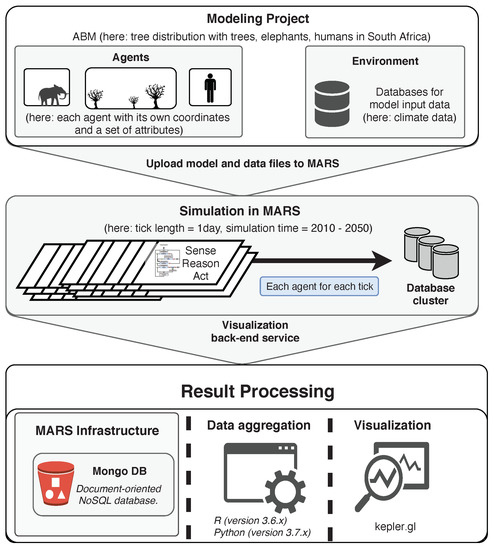
Figure A1.
Illustration of technical workflow from model initialization to result storage.
Appendix B.1. Agent Type: Tree
In a perfect world, seeds receive water from rainfall within the first 12 days, have enough space to germinate (for more details, see Table A1), and thereby survive the first probability to die [68]. Thereafter, in the simulation, the seed becomes an instance of the agent type Tree. The species of that single tree is derived from the seed, which was produced by an adult tree. The first state is Seedling. In this state, the tick-based behavior (see Figure A2) brings the Seedling to a Juvenile if it is still alive at the start of the next vegetation year (October 1). Trees grow only when they have leaves. For this study, all trees have leaves from October 1 to March 31. For the daily tick routine, the total growing in one year is divided in the value of the attribute DaysWithLeavesOn. In the states Juvenile and Adult, each tree has the attributes: aboveground biomass (AGB), stem diameter, maximum growth rate, damage class, and the ability to switch from LeavesOn in photosynthetic active growing season to LeavesOff. For each species, there is a threshold by stem diameter to change between states (see Table A2). Only adult trees are able to produce seeds. In March, an adult tree spawns 50 seeds in its surroundings [67]. With the first rainfall after spawning, the life cycle starts again. The daily tick routine of Juvenile and Adult trees (see Figure A3) starts with a check of new damage because damage has the most impact on the trees.

Table A1.
Need for space for establishment.
Table A1.
Need for space for establishment.
| Radius (cm) of No Establishment When Neighbored by | Seedling | Juvenile | Adult |
|---|---|---|---|
| A.n. | 4 | 32 | 80 |
| C.a. | 4 | 40 | 80 |
| S.b. | 4 | 80 | 500 |
| T.t. | 4 | 52 | 220 |
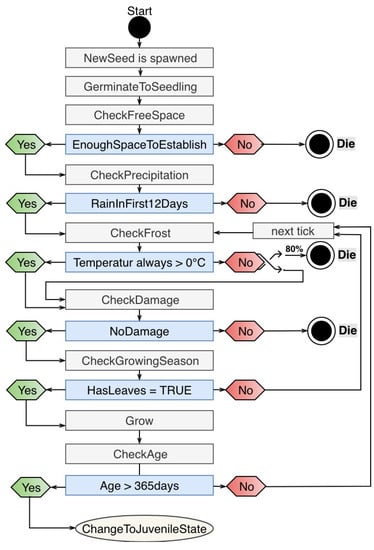
Figure A2.
Daily tick routine for Tree agent in seedling state.
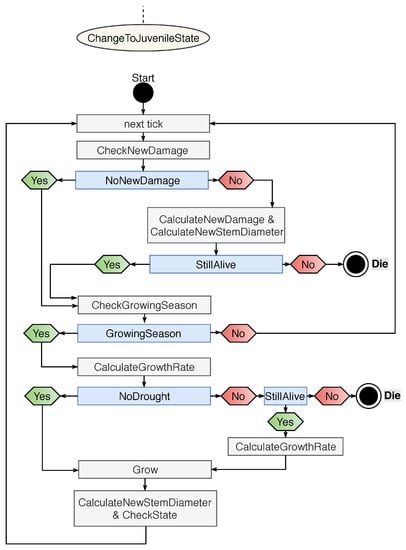
Figure A3.
Daily tick routine for juvenile and adult Tree.

Table A2.
Age types classification by stem diameter.
Table A2.
Age types classification by stem diameter.
| A.n. | C.a. | S.b. | T.t. | |
|---|---|---|---|---|
| Seedling | <1 | <1 | <1 | <1 |
| Juvenile | 1–8 | 1–10 | 1–20 | 1–13 |
| Adult | >8 | >10 | >20 | >13 |
| Max. | 20 | 20 | 50 | 30 |
Growth Rates—Juveniles
The maximum growth rate (max) per species based on undisturbed average diameter and time span to become an adult tree. In the following equations, represents the stem diameter during the simulation tick i.
Growth Rates—Adults
- Definition reduceFactor: The growth rate is reduced by damage. For damage type N, the growth rate is maximized; damage type L reduces the growth rate randomly between 0–10%; damage type M reduces the growth rate randomly between 10–30%; and damage type H reduce the growth rate randomly between 30–60%. By damage type X, the tree falls back into the juvenile state or dies.
- Definition growthRate: Because Combretum apiculatum grows more slowly than Acacia nigescens and Sclerocarya birrea, a growthRate value was integrated. The value for Acadia is 0.5, and 1 for all species.
- Definition MaxStemDiameter (): The maximum stem diameter differs by species. It is 20 cm for A.n.; 20 cm for C.a.; 50 cm for S.b., and 30 cm for T.t.
Calculation from Stem Diameter to Woody Biomass
The AGB for each species was calculated based on [17]. Dried woody biomass is only 60% of the AGB. The formulas were modified accordingly. For the species, the formulas are:
Appendix B.2. Agent Type: FirewoodCollector
The agent type FirewoodCollector is modeled with GOAP. To calculate the best sequence of actions, there must be a list of actions and costs (Table A3). The tick routine of the FirewoodCollector is illustrated in Figure A4.

Table A3.
Actions and cost for firewood collection.
Table A3.
Actions and cost for firewood collection.
| Action | Cost |
|---|---|
| CutBranchAn | 50 |
| CutBranchCa | 50 |
| CutBranchSb | 90 |
| CutBranchTt | 50 |
| CutShoot | 30 |
| CollectDeadWood | 10 |
| CarryWoodHome | 0 |
| AbortAndGoHome | 0 |
| EvaluateAndPackWoodForTransport | 0 |

Figure A4.
Daily tick routine for FirewoodCollector.
Appendix B.3. Agent Type: Elephant
During the dry season and especially in September, up to 94% of the elephant diet consists of woody biomass [59]. The different utilization of trees by elephant from [59,61,62,68,78,79] were included (see Table A4).

Table A4.
Ranking of Elephant interactions.
Table A4.
Ranking of Elephant interactions.
| Elephant Interactions | |
|---|---|
| Food preferences | Fresh grass > fresh leaves > twig, bark, and roots |
| Ringbarking (by food/water stress) | A.n. > S.b. ≫ C.a. |
| Pushover (by food/water stress) | Juvenile A.n. > S.b. |
| No damage | Stem diameter cm |
Figure A5 shows the tick routine of the elephant. Damage to the trees varies depending on the month, tree species, droughts, and state of the tree [59,60,61,62].
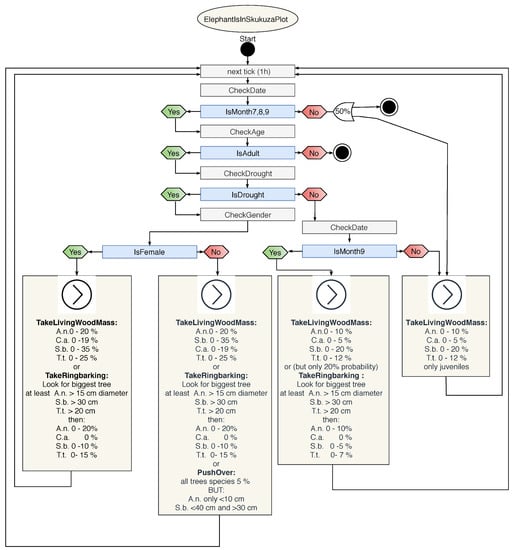
Figure A5.
Elephant hourly tick routine in the SKU Model.
References
- Blanco, C.C.; Scheiter, S.; Sosinski, E.; Fidelis, A.; Anand, M.; Pillar, V.D. Feedbacks between vegetation and disturbance processes promote long-term persistence of forest-grassland mosaics in south Brazil. Ecol. Model. 2014, 291, 224–232. [Google Scholar] [CrossRef]
- Helm, C.V.; Scott, S.L.; Witkowski, E.T.F. Reproductive potential and seed fate of Sclerocarya birrea subsp. caffra (marula) in the low altitude savannas of South Africa. S. Afr. J. Bot. 2011, 77, 650–664. [Google Scholar] [CrossRef]
- Jacobs, O.S.; Biggs, R. The status and population structure of the marula in the Kruger National Park. S. Afr. J. Wildl. Res. 2002, 32, 1–12. [Google Scholar]
- Manning, A.D.; Fischer, J.; Lindenmayer, D.B. Scattered trees are keystone structures—Implications for conservation. Biol. Conserv. 2006, 132, 311–321. [Google Scholar] [CrossRef]
- Stevens, N.; Swemmer, A.M.; Ezzy, L.; Erasmus, B.F.N. Investigating potential determinants of the distribution limits of a savanna woody plant: Colophospermum mopane. J. Veg. Sci. 2014, 25, 363–373. [Google Scholar] [CrossRef]
- Accatino, F.; Wiegand, K.; Ward, D.; De Michele, C. Trees, grass, and fire in humid savannas-The importance of life history traits and spatial processes. Ecol. Model. 2016, 320, 135–144. [Google Scholar] [CrossRef]
- Colgan, M.S.; Martin, R.E.; Baldeck, C.A.; Asner, G.P. Tree foliar chemistry in an African savanna and its relation to life history strategies and environmental filters. PLoS ONE 2015, 10, e0124078. [Google Scholar] [CrossRef][Green Version]
- Higgins, S.I.; Bond, W.J.; Combrink, H.; Craine, J.M.; February, E.C.; Govender, N.; Lannas, K.; Moncreiff, G.; Trollope, W.S.W. Which traits determine shifts in the abundance of tree species in a fire-prone savanna? J. Ecol. 2012, 100, 1400–1410. [Google Scholar] [CrossRef]
- Lenfers, U.A.; Brüggemann, R.; Clemen, T. Exploring survival strategies of African Savanna trees by partial ordering techniques. Ecol. Inform. 2017, 42, 14–23. [Google Scholar] [CrossRef]
- Tomlinson, K.W.; Poorter, L.; Sterck, F.J.; Borghetti, F.; Ward, D.; de Bie, S.; van Langevelde, F. Leaf adaptations of evergreen and deciduous trees of semi-arid and humid savannas on three continents. J. Ecol. 2013, 101, 430–440. [Google Scholar] [CrossRef]
- Coates-Palgrave, K. Trees of Southern Africa, 3rd ed.; Struik Nature, Penguin Random House (Pty) Ltd.: Century City, South Africa, 2002; p. 1212. [Google Scholar]
- Fisher, J.T.; Witkowski, E.T.; Erasmus, B.F.; Van Aardt, J.; Asner, G.P.; Wessels, K.J.; Mathieu, R. Human-modified landscapes: Patterns of fine-scale woody vegetation structure in communal savannah rangelands. Environ. Conserv. 2012, 39, 72–82. [Google Scholar] [CrossRef]
- Kaschula, S.A.; Twine, W.E.; Scholes, M.C. Coppice harvesting of fuelwood species on a South African common: Utilizing scientific and indigenous knowledge in Community Based Natural Resource Management. Hum. Ecol. 2005, 33, 387–418. [Google Scholar] [CrossRef]
- Lenfers, U.A.; Weyl, J.; Clemen, T. Firewood Collection in South Africa: Adaptive Behavior in Social-Ecological Models. Land 2018, 7, 97. [Google Scholar] [CrossRef]
- Madubansi, M.; Shackleton, C.M. Changes in fuelwood use and selection following electrification in the Bushbuckridge lowveld, South Africa. J. Environ. Manag. 2007, 83, 416–426. [Google Scholar] [CrossRef] [PubMed]
- Mograbi, P.J.; Witkowski, E.T.; Erasmus, B.F.; Asner, G.P.; Fisher, J.T.; Mathieu, R.; Wessels, K.J. Fuelwood extraction intensity drives compensatory regrowth in African savanna communal lands. Land Degrad. Dev. 2019, 30, 190–201. [Google Scholar] [CrossRef]
- Nickless, A.; Scholes, R.J.; Archibald, S. A method for calculating the variance and confidence intervals for tree biomass estimates obtained from allometric equations. S. Afr. J. Sci. 2011, 107, 1–10. [Google Scholar] [CrossRef]
- Odipo, V.; Nickless, A.; Berger, C.; Baade, J.; Urbazaev, M.; Walther, C.; Schmullius, C. Assessment of Aboveground Woody Biomass Dynamics Using Terrestrial Laser Scanner and L-Band ALOS PALSAR Data in South African Savanna. Forests 2016, 7, 294. [Google Scholar] [CrossRef]
- Scholes, R.J.; Gureja, N.; Giannecchinni, M.; Dovie, D.; Wilson, B.; Davidson, N.; Piggott, K.; McLoughlin, C.; Van der Velde, K.; Freeman, A.; et al. The environment and vegetation of the flux measurement site near Skukuza, Kruger National Park. Koedoe 2001, 44, 73–84. [Google Scholar] [CrossRef]
- Statistics South Africa. South African Community Survey 2016. Available online: https://www.statssa.gov.za (accessed on 30 March 2022).
- Banks, D.I.; Griffin, N.J.; Shackleton, C.M.; Shackleton, S.E.; Mavrandonis, J.M. Wood supply and demand around two rural settlements in a semi-arid Savanna, South Africa. Biomass Bioenergy 1996, 11, 319–331. [Google Scholar] [CrossRef]
- Emanuel, P.L.; Shackleton, C.M.; Baxter, J.S. Modelling the sustainable harvest of Sclerocarya birrea subsp. caffra fruits in the South African lowveld. For. Ecol. Manag. 2005, 214, 91–103. [Google Scholar] [CrossRef]
- Munalula, F.; Meincken, M. An evaluation of South African fuelwood with regards to calorific value and environmental impact. Biomass Bioenergy 2009, 33, 415–420. [Google Scholar] [CrossRef]
- Scheiter, S.; Schulte, J.; Pfeiffer, M.; Martens, C.; Erasmus, B.F.; Twine, W.C. How Does Climate Change Influence the Economic Value of Ecosystem Services in Savanna Rangelands? Ecol. Econ. 2019, 157, 342–356. [Google Scholar] [CrossRef]
- Twine, W.C.; Holdo, R.M. Fuelwood sustainability revisited: Integrating size structure and resprouting into a spatially realistic fuelshed model. J. Appl. Ecol. 2016, 53, 1766–1776. [Google Scholar] [CrossRef]
- Wessels, K.J.; Colgan, M.S.; Erasmus, B.F.; Asner, G.P.; Twine, W.C.; Mathieu, R.; Van Aardt, J.A.; Fisher, J.T.; Smit, I.P. Unsustainable fuelwood extraction from South African savannas. Environ. Res. Lett. 2013, 8, 014007. [Google Scholar] [CrossRef]
- Baxter, P.W.J. Modeling the Impact of the African Elephant, Loxodonta africana, on Woody Vegetation in Semi-Arid Savannas. Ph.D. Thesis, University of California, Berkeley, CA, USA, 2003. [Google Scholar]
- Bonan, G.; Levis, S.; Sitch, S. A dynamic global vegetation model for use with climate models: Concepts and description of simulated vegetation dynamics. Glob. Chang. Biol. 2003, 9, 1543–1566. [Google Scholar] [CrossRef]
- Jeltsch, F.; Milton, S.J.; Dean, W.R.; Van Rooyen, N.; Moloney, K.A. Modelling the impact of small-scale heterogeneities on tree-grass coexistence in semi-arid savannas. J. Ecol. 1998, 86, 780–793. [Google Scholar] [CrossRef]
- Liedloff, A.C.; Cook, G.D. Modelling the effects of rainfall variability and fire on tree populations in an Australian tropical savanna with the Flames simulation model. Ecol. Model. 2007, 201, 269–282. [Google Scholar] [CrossRef]
- Moncrieff, G.R.; Scheiter, S.; Slingsby, J.A.; Higgins, S.I. Understanding global change impacts on South African biomes using Dynamic Vegetation Models. S. Afr. J. Bot. 2015, 101, 16–23. [Google Scholar] [CrossRef]
- Scholtz, R.; Kiker, G.A.; Smit, I.P.; Venter, F.J. Identifying drivers that influence the spatial distribution of woody vegetation in Kruger National Park, South Africa. Ecosphere 2014, 5, 71. [Google Scholar] [CrossRef]
- Mograbi, P.; Erasmus, B.; Witkowski, E.; Asner, G.; Wessels, K.; Mathieu, R.; Knapp, D.; Martin, R.; Main, R. Biomass increases go under cover: Woody vegetation dynamics in a communally utilized semi-arid savanna in Bushbuckridge, South Africa. S. Afr. J. Bot. 2015, 98, 191–192. [Google Scholar] [CrossRef]
- Gaylard, A. Adopting a Heterogeneity Paradigm for Understanding and Managing Elephants for Biodiversity: A Case Study in Riparian Woodlands in Kruger National Park. Ph.D. Thesis, University of the Witwatersrand, Johannesburg, South Africa, 2015. [Google Scholar]
- Clemen, T.; Lenfers, U.A.; Dybulla, J.; Ferreira, S.M.; Kiker, G.A.; Martens, C.; Scheiter, S. A cross-scale modeling framework for decision support on elephant management in Kruger National Park, South Africa. Ecol. Inform. 2021, 62, 101266. [Google Scholar] [CrossRef]
- Smit, I.P.J.; Asner, G.P.; Govender, N.; Vaughn, N.R.; van Wilgen, B.W. An examination of the potential efficacy of high-intensity fires for reversing woody encroachment in savannas. J. Appl. Ecol. 2016, 53, 1623–1633. [Google Scholar] [CrossRef]
- Bond, W.J.; Midgley, G.F.; Woodward, F.I. What controls South African vegetation—Climate or fire? S. Afr. J. Bot. 2003, 69, 79–91. [Google Scholar] [CrossRef]
- Trollope, W.; Trollope, L.; Biggs, H.; Pienaar, D.; Potgieter, A. Long-term changes in the woody vegetation of the Kruger National Park, with special reference to the effects of elephants and fire. Koedoe 1998, 41, 103–112. [Google Scholar] [CrossRef]
- SANparks. Kruger National Park, Kruger Management Plan, for the Period 2018–2028. 2018. Available online: https://www.sanparks.org/assets/docs/conservation/park_man/knp/knp-approved-plan.pdf (accessed on 19 April 2022).
- Engelbrecht, F.; Adegoke, J.; Bopape, M.J.; Naidoo, M.; Garland, R.; Thatcher, M.; McGregor, J.; Katzfey, J.; Werner, M.; Ichoku, C.; et al. Projections of rapidly rising surface temperatures over Africa under low mitigation. Environ. Res. Lett. 2015, 10. [Google Scholar] [CrossRef]
- Grimm, V.; Berger, U.; Bastiansen, F.; Eliassen, S.; Ginot, V.; Giske, J.; Goss-Custard, J.; Grand, T.; Heinz, S.K.; Huse, G.; et al. A standard protocol for describing individual-based and agent-based models. Ecol. Model. 2006, 198, 115–126. [Google Scholar] [CrossRef]
- Grimm, V.; Berger, U.; DeAngelis, D.L.; Polhill, J.G.; Giske, J.; Railsback, S.F. The ODD protocol: A review and first update. Ecol. Model. 2010, 221, 2760–2768. [Google Scholar] [CrossRef]
- Rutherford, M.C.; Mucina, L.; Lötter, C.; Bredenkamp, G.J.; Jacobus, H.L.; Scott-shaw, C.R.; Hoare, D.B.; Goodman, S.; Bezuidenhout, H.; Scott, L.; et al. Savanna Biome. Vegetation of South Africa, Lesotho & Swaziland. arXiv 2006, arXiv:1011.1669v3, 439–539. [Google Scholar]
- Shackleton, C.M.; Griffin, N.J.; Banks, D.I.; Mavrandonis, J.M.; Shackleton, S.E. Community structure and species composition along a disturbance gradient in a communally managed South African savanna. Vegetatio 1994, 115, 157–167. [Google Scholar] [CrossRef]
- Berger, C.; Bieri, M.; Bradshaw, K.; Brümmer, C.; Clemen, T.; Hickler, T.; Kutsch, W.L.; Lenfers, U.A.; Martens, C.; Midgley, G.F.; et al. Linking scales and disciplines: An interdisciplinary cross-scale approach to supporting climate-relevant ecosystem management. Clim. Chang. 2019, 156, 139–150. [Google Scholar] [CrossRef]
- Matsika, R.; Erasmus, B.F.; Twine, W.C. Double jeopardy: The dichotomy of fuelwood use in rural South Africa. Energy Policy 2013, 52, 716–725. [Google Scholar] [CrossRef]
- Mograbi, P.; Asner, G.; Witkowski, E.; Erasmus, B.; Wessels, K.; Mathieu, R.; Vaughn, N. Humans and elephants as treefall drivers in African savannas. Ecography 2016, 40, 1–11. [Google Scholar] [CrossRef]
- Twine, W.C. Personal Comment, 2019. Made during EMSAfrica Stakeholder Meeting at Wits Rural Facility on 8 March 2019.
- Kelly, R.A.; Jakeman, A.J.; Barreteau, O.; Borsuk, M.E.; ElSawah, S.; Hamilton, S.H.; Henriksen, H.J.; Kuikka, S.; Maier, H.R.; Rizzoli, A.E.; et al. Selecting among five common modelling approaches for integrated environmental assessment and management. Environ. Model. Softw. 2013, 47, 159–181. [Google Scholar] [CrossRef]
- Bonabeau, E. Agent-based modeling: Methods and techniques for simulating human systems. Proc. Natl. Acad. Sci. USA 2002, 99, 7280–7287. [Google Scholar] [CrossRef]
- Glake, D.; Weyl, J.; Dohmen, C.; Hüning, C.; Clemen, T. Modeling through model transformation with MARS 2.0. In Proceedings of the ADS’17: Proceedings of the Agent-Directed Simulation Symposium, Virginia Beach, VA, USA, 23–26 April 2017; Volume 49, pp. 13–24. [CrossRef][Green Version]
- Hüning, C.; Dalski, J.; Adebahr, M.; Lenfers, U.; Thiel-Clemen, T.; Grundmann, L. Modeling & simulation as a service with the massive multi-agent system MARS. Simulation Series. In Proceedings of the Society for Computer Simulation International (ADS ’16), Pasadena, CA, USA, 3–6 April 2016; Volume 48, pp. 1–8. [Google Scholar] [CrossRef]
- Weyl, J.; Glake, D.; Clemen, T. Agent-based Traffic Simulation at City Scale with MARS. In Proceedings of the 2018 Spring Simulation Multiconference, Baltimore, MD, USA, 15–18 April 2018; p. 9. [Google Scholar]
- Charles-Dominique, T.; Midgley, G.F.; Tomlinson, K.W.; Bond, W.J. Steal the light: Shade vs fire adapted vegetation in forest–savanna mosaics. New Phytol. 2018, 218, 1419–1429. [Google Scholar] [CrossRef]
- Stevens, N.; Lehmann, C.E.R.; Murphy, B.P.; Durigan, G. Savanna woody encroachment is widespread across three continents. Glob. Chang. Biol. 2017, 23, 235–244. [Google Scholar] [CrossRef]
- Wigley, B.J.; Slingsby, J.A.; Díaz, S.; Bond, W.J.; Fritz, H.; Coetsee, C. Leaf traits of African woody savanna species across climate and soil fertility gradients: Evidence for conservative versus acquisitive resource-use strategies. J. Ecol. 2016, 104, 1357–1369. [Google Scholar] [CrossRef]
- Wright, I.J.; Westoby, M.; Reich, P.B.; Oleksyn, J.; Ackerly, D.D.; Baruch, Z.; Bongers, F.; Cavender-Bares, J.; Chapin, T.; Cornellissen, J.H.C.; et al. The worldwide leaf economics spectrum. Nature 2004, 428, 821–827. [Google Scholar] [CrossRef]
- Wright, I.J.; Reich, P.B.; Cornelissen, J.H.C.; Falster, D.S.; Groom, P.K.; Hikosaka, K.; Lee, W.; Lusk, C.H.; Niinemets, Ü.; Oleksyn, J.; et al. Modulation of leaf economic traits and trait relationships by climate. Glob. Ecol. Biogeogr. 2005, 14, 411–421. [Google Scholar] [CrossRef]
- Jacobs, O.S.; Biggs, R. The impact of the African elephant on marula trees in the Kruger National Park. S. Afr. J. Wildl. Res. 2002, 32, 13–22. [Google Scholar]
- Cook, R.M.; Witkowski, E.T.; Helm, C.V.; Henley, M.D.; Parrini, F. Recent exposure to African elephants after a century of exclusion: Rapid accumulation of marula tree impact and mortality, and poor regeneration. For. Ecol. Manag. 2017, 401, 107–116. [Google Scholar] [CrossRef]
- Moncrieff, G.R.; Kruger, L.M.; Midgley, J.J. Stem mortality of Acacia nigrescens induced by the synergistic effects of elephants and fire in Kruger National Park, South Africa. J. Trop. Ecol. 2008, 24, 655–662. [Google Scholar] [CrossRef]
- Shannon, G.; Druce, D.J.; Page, B.R.; Eckhardt, H.C.; Grant, R.; Slotow, R. The utilization of large savanna trees by elephant in southern Kruger National Park. J. Trop. Ecol. 2008, 24, 281–289. [Google Scholar] [CrossRef]
- Case, M.F.; Wigley-Coetsee, C.; Nzima, N.; Scogings, P.F.; Staver, A.C. Severe drought limits trees in a semi-arid savanna. Ecology 2019, 100, e02842. [Google Scholar] [CrossRef] [PubMed]
- Shackleton, C.M. Annual production of harvestable deadwood in semi-arid savannas, South Africa. For. Ecol. Manag. 1998, 112, 139–144. [Google Scholar] [CrossRef]
- Fornara, D.A. Ungulate Browsing and Plant Defensive Traits: Modelling Changes in Plant Productivity and Soil Nutrient Availability in Savanna. Ph.D. Thesis, University of Pretoria, Pretoria, South Africa, 2005. [Google Scholar]
- Allen, C.D.; Macalady, A.K.; Chenchouni, H.; Bachelet, D.; McDowell, N.; Vennetier, M.; Kitzberger, T.; Rigling, A.; Breshears, D.D.; Hogg, E.H.; et al. A global overview of drought and heat-induced tree mortality reveals emerging climate change risks for forests. For. Ecol. Manag. 2010, 259, 660–684. [Google Scholar] [CrossRef]
- Baxter, P.W.; Getz, W.M. Development and parameterization of a rain- and fire-driven model for exploring elephant effects in African savannas. Environ. Model. Assess. 2008, 13, 221–242. [Google Scholar] [CrossRef]
- Campbell, B.M. The Miombo in Transition: Woodlands and Welfare in Africa; Center for International Forestry Research (CIFOR): Bogor, Indonesia, 1996; p. 273. [Google Scholar] [CrossRef]
- Dube, P.; Musara, C.; Chitamba, J. Extinction Threat to Tree Species from Firewood Use in the Wake of Electric Power Cuts: A Case Study of Bulawayo, Zimbabwe. Resour. Environ. 2014, 4, 260–267. [Google Scholar] [CrossRef]
- Holdo, R. Tree growth in an African woodland savanna affected by disturbance. J. Veg. Sci. 2006, 17, 369–378. [Google Scholar] [CrossRef]
- Shackleton, C.M.; Scholes, R.J. Above ground woody community attributes, biomass and carbon stocks along a rainfall gradient in the savannas of the central lowveld, South Africa. S. Afr. J. Bot. 2011, 77, 184–192. [Google Scholar] [CrossRef]
- Archer, E.; Engelbrecht, F.; Haensler, A.; Landman, W.; Tadross, M.; Helmschrot, J. Seasonal prediction and regional climate projections for southern Africa. In Climate Change and Adaptive Land Management in Southern Africa—Assessments, Changes, Challenges, and Solutions; Revermann, R., Krewenka, K., Schmiedel, U., Olwoch, J., Helmschrot, J., Juergens, N., Eds.; Klaus Hess Publishers: Goettingen, Germany; Windhoek, Namibia, 2018; Volume 6, pp. 14–21. [Google Scholar] [CrossRef]
- Meinshausen, M.; Smith, S.J.; Calvin, K.; Daniel, J.S.; Kainuma, M.L.; Lamarque, J.; Matsumoto, K.; Montzka, S.A.; Raper, S.C.; Riahi, K.; et al. The RCP greenhouse gas concentrations and their extensions from 1765 to 2300. Clim. Chang. 2011, 109, 213–241. [Google Scholar] [CrossRef]
- Possell, M.; Nicholas Hewitt, C. Gas exchange and photosynthetic performance of the tropical tree Acacia nigrescens when grown in different CO2 concentrations. Planta 2009, 229, 837–846. [Google Scholar] [CrossRef] [PubMed]
- Díaz, S.; Purvis, A.; Cornelissen, J.H.C.; Mace, G.M.; Donoghue, M.J.; Ewers, R.M.; Jordano, P.; Pearse, W.D. Functional traits, the phylogeny of function, and ecosystem service vulnerability. Ecol. Evol. 2013, 3, 2958–2975. [Google Scholar] [CrossRef] [PubMed]
- Stevens, N.; Erasmus, B.F.N.; Archibald, S.; Bond, W.J. Woody encroachment over 70 years in South African savannahs: Overgrazing, global change or extinction aftershock? Philos. Trans. R. Soc. B Biol. Sci. 2016, 371, 20150437. [Google Scholar] [CrossRef]
- Scholes, R.J.; Walker, B.H. An African Savanna: Synthesis of the Nylsvley Study; Cambridge University Press: Cambridge, UK, 1993. [Google Scholar] [CrossRef]
- Cook, G.D.; Liedloff, A.C.; Eager, R.W.; Chen, X.; Williams, R.J.; O’Grady, A.P.; Hutley, L.B. The estimation of carbon budgets of frequently burnt tree stands in savannas of northern Australia, using allometric analysis and isotopic discrimination. Aust. J. Bot. 2005, 53, 621–630. [Google Scholar] [CrossRef]
- Gillson, L. Evidence of a tipping point in a southern African savanna? Ecol. Complex. 2015, 21, 78–86. [Google Scholar] [CrossRef]
Publisher’s Note: MDPI stays neutral with regard to jurisdictional claims in published maps and institutional affiliations. |
© 2022 by the authors. Licensee MDPI, Basel, Switzerland. This article is an open access article distributed under the terms and conditions of the Creative Commons Attribution (CC BY) license (https://creativecommons.org/licenses/by/4.0/).